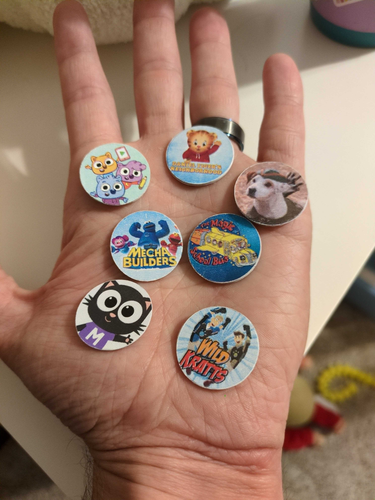Child-Friendly Media Player
A solution to give a child autonomy over screen time without a tablet I have a kid. She likes watching shows. Those shows are not necessarily easy to play to a screen without controlling the system through a phone/tablet/whatever. I want to give her autonomy over choosing what to watch during her allowed time without giving her a second, smaller screen to control the bigger screen. We discussed a DVD player, but DVD menus are useless for someone who can’t read yet and DVDs are notoriously easy for kids to destroy. We also ran into the issue of a lot of shows or movies not being on physical media. I was looking for a solution that had these requirements: After dozens of seconds of searching for a solution, I decided to make my own. The core solution was based on a NFC Hat for a raspberry pi, a big pile of 25mm circle NFC tags, and some sticker paper. We went to the library with some sticker paper and a bunch of images on a thumb drive and used their sticker-making software to print out two stickers for each show and attached them to tokens at random. After putting the stickers on the tokens, I used the demo software that came with the NFC Hat to get the token UID for each one and noted down which token ID went with which show. These UIDs and names made it into a config file that looks something like this: The shows and movies that we wanted available break down into three categories: For the first (and most important) category, we need to take a look at the PBS Kids API. You can access a list of currently running shows using their show-tracking endpoint. That endpoint will show you a blob of JSON that contains the title and a “slug” for each show. Take that slug and swap it into the Some example python to grab a video link for a given stub: We have plenty of off-air PBS shows, too. Wishbone, Magic School Bus, Between the Lions, etc. For these shows, I have a network location set as the matching configuration and do a walk of the directory and pick a random episode from the pile. This one is pretty straightforward, if the mapping config file links to a specific file, just play the specific fileThe Problem

The Solution

Elinor|4,177,151,158,36,2,137|elinor-wonders-why
Toy Story 2|4,33,155,60,36,2,137|/mnt/Media/Kids Movies/Toy Story 2 (1999).mp4
Wishbone|4,81,32,160,36,2,137|/mnt/Media/Kids TV/Wishbone (1995)/
The Technical Bits
PBS Kids API
shows parameter on their show-list endpoint and you can see the list of available episodes for a given show.
= f
=
=
=
return
Off-Air PBS shows
=
return
Local Movies
return
Full python file
= f
=
=
=
return
=
=
=
return
return
return
=
, , , =
# Configure PN532 to communicate with MiFare cards
=
continue
=
=
=
=
continue
break